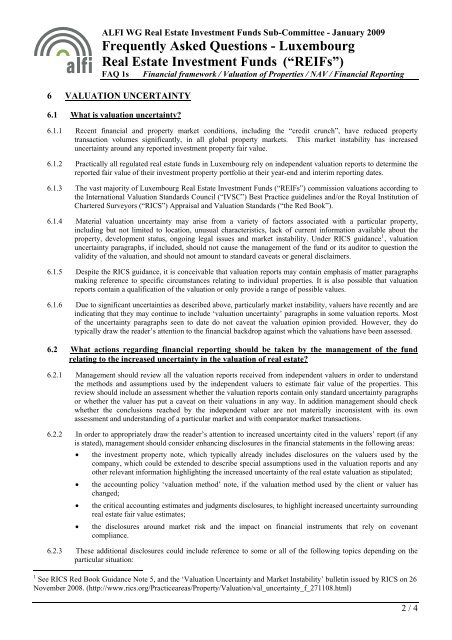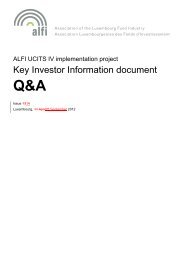Real Estate fund matters - Alfi
Real Estate fund matters - Alfi
Real Estate fund matters - Alfi
Create successful ePaper yourself
Turn your PDF publications into a flip-book with our unique Google optimized e-Paper software.
ALFI WG <strong>Real</strong> <strong>Estate</strong> Investment Funds Sub-Committee - January 2009<br />
Frequently Asked Questions - Luxembourg<br />
<strong>Real</strong> <strong>Estate</strong> Investment Funds (“REIFs”)<br />
FAQ 1s Financial framework / Valuation of Properties / NAV / Financial Reporting<br />
6 0BUVALUATION UNCERTAINTY<br />
6.1 1BUWhat is valuation uncertainty?<br />
6.1.1 7BRecent financial and property market conditions, including the “credit crunch”, have reduced property<br />
transaction volumes significantly, in all global property markets. This market instability has increased<br />
uncertainty around any reported investment property fair value.<br />
6.1.2 8BPractically all regulated real estate <strong>fund</strong>s in Luxembourg rely on independent valuation reports to determine the<br />
reported fair value of their investment property portfolio at their year-end and interim reporting dates.<br />
6.1.3 9BThe vast majority of Luxembourg <strong>Real</strong> <strong>Estate</strong> Investment Funds (“REIFs”) commission valuations according to<br />
the International Valuation Standards Council (“IVSC”) Best Practice guidelines and/or the Royal Institution of<br />
Chartered Surveyors (“RICS”) Appraisal and Valuation Standards (“the Red Book”).<br />
6.1.4 10BMaterial valuation uncertainty may arise from a variety of factors associated with a particular property,<br />
including but not limited to location, unusual characteristics, lack of current information available about the<br />
1<br />
property, development status, ongoing legal issues and market instability. Under RICS guidanceF F, valuation<br />
uncertainty paragraphs, if included, should not cause the management of the <strong>fund</strong> or its auditor to question the<br />
validity of the valuation, and should not amount to standard caveats or general disclaimers.<br />
6.1.5 11BDespite the RICS guidance, it is conceivable that valuation reports may contain emphasis of matter paragraphs<br />
making reference to specific circumstances relating to individual properties. It is also possible that valuation<br />
reports contain a qualification of the valuation or only provide a range of possible values.<br />
6.1.6 12BDue to significant uncertainties as described above, particularly market instability, valuers have recently and are<br />
indicating that they may continue to include ‘valuation uncertainty’ paragraphs in some valuation reports. Most<br />
of the uncertainty paragraphs seen to date do not caveat the valuation opinion provided. However, they do<br />
typically draw the reader’s attention to the financial backdrop against which the valuations have been assessed.<br />
6.2 2BUWhat actions regarding financial reporting should be taken by the management of the <strong>fund</strong><br />
relating to the increased uncertainty in the valuation of real estate?<br />
6.2.1 13BManagement should review all the valuation reports received from independent valuers in order to understand<br />
the methods and assumptions used by the independent valuers to estimate fair value of the properties. This<br />
review should include an assessment whether the valuation reports contain only standard uncertainty paragraphs<br />
or whether the valuer has put a caveat on their valuations in any way. In addition management should check<br />
whether the conclusions reached by the independent valuer are not materially inconsistent with its own<br />
assessment and understanding of a particular market and with comparator market transactions.<br />
6.2.2 14BIn<br />
order to appropriately draw the reader’s attention to increased uncertainty cited in the valuers’ report (if any<br />
is stated), management should consider enhancing disclosures in the financial statements in the following areas:<br />
• the investment property note, which typically already includes disclosures on the valuers used by the<br />
company, which could be extended to describe special assumptions used in the valuation reports and any<br />
other relevant information highlighting the increased uncertainty of the real estate valuation as stipulated;<br />
• the accounting policy ‘valuation method’ note, if the valuation method used by the client or valuer has<br />
changed;<br />
• the critical accounting estimates and judgments disclosures, to highlight increased uncertainty surrounding<br />
real estate fair value estimates;<br />
• the disclosures around market risk and the impact on financial instruments that rely on covenant<br />
compliance.<br />
6.2.3 15BThese additional disclosures could include reference to some or all of the following topics depending on the<br />
particular situation:<br />
1 See RICS Red Book Guidance Note 5, and the ‘Valuation Uncertainty and Market Instability’ bulletin issued by RICS on 26<br />
November 2008. (http://www.rics.org/Practiceareas/Property/Valuation/val_uncertainty_f_271108.html)<br />
2 / 4

















